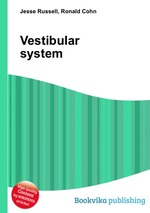Vestibular system
Jesse Russell Ronald Cohn
бумажная книга
High Quality Content by WIKIPEDIA articles! The vestibular system, which contributes to balance in most mammals and to the sense of spatial orientation, is the sensory system that provides the leading contribution about movement and sense of balance. Together with the cochlea, a part of the auditory system, it constitutes the labyrinth of the inner ear in most mammals, situated in the vestibulum in the inner ear (Figure 1). As our movements consist of rotations and translations, the vestibular system comprises two components: the semicircular canal system, which indicate rotational movements; and the otoliths, which indicate linear accelerations. The vestibular system sends signals primarily to the neural structures that control our eye movements, and to the muscles that keep us upright . The projections to the former provide the anatomical basis of the vestibulo-ocular reflex, which is required for clear vision; and the projections to the muscles that control our posture are necessary to keep us upright.


